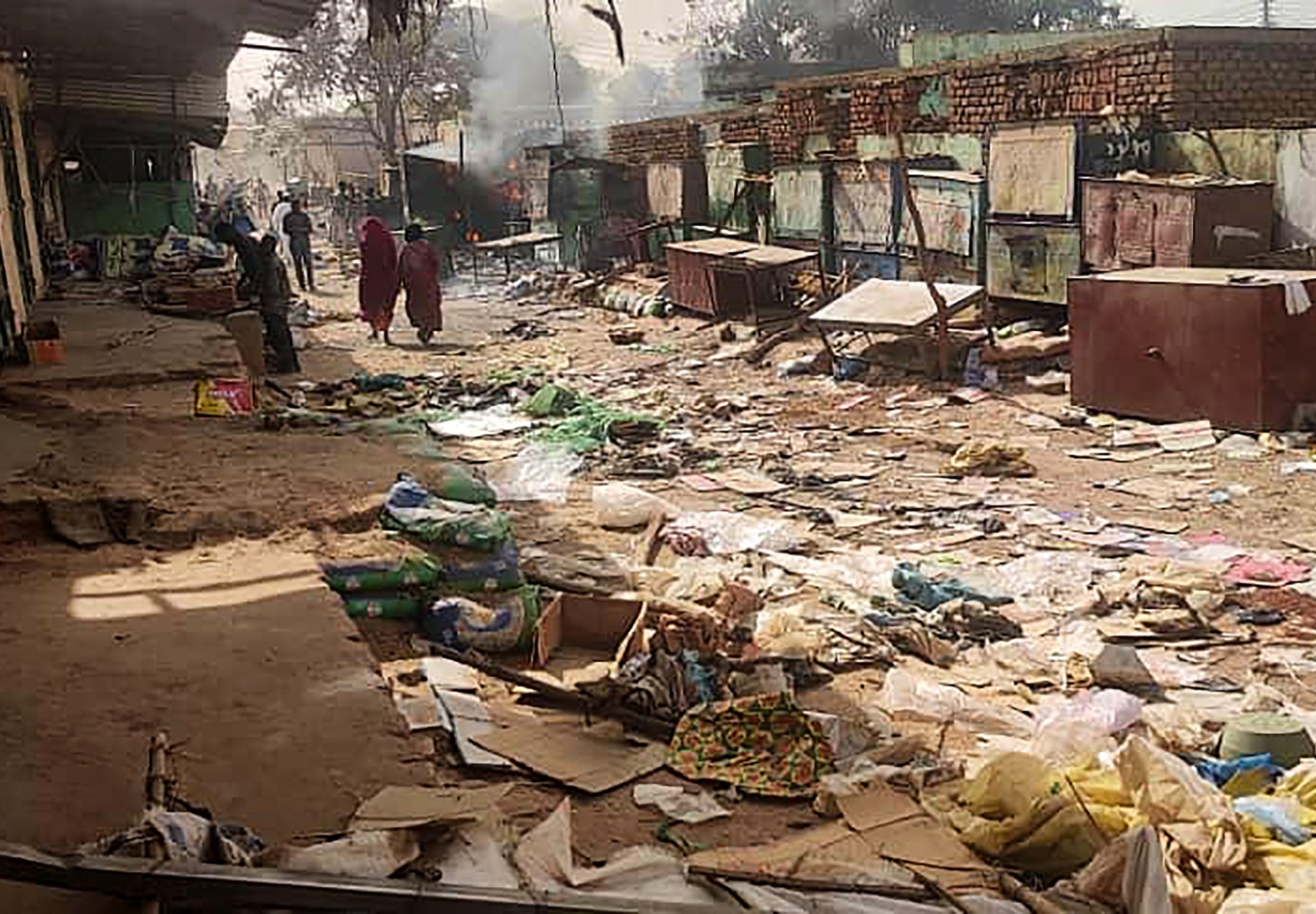One of India’s last royal khansamas, and his raan kabab
The raan kababs Majid Khansama aka Majid Bhai prepared for us on the first Eid after our marriage was nothing like the usual leg of mutton we used to cook post-Eid al-Adha, when the refrigerator was replete with the choicest pieces.
Maybe it was our happiness that had seeped into the intense flavours of the dish, but I can still recall the supreme contentment of that meal and the sense that the dish alone could sustain the Eid table.
Eid al-Adha (the Festival of Sacrifice) is the more dramatic, even emotional, of the two Eids celebrated by Muslims. The level of emotion depends on our engagement with its spirit. Eid al-Adha, also known as Bakr Eid in the Indian subcontinent, is born out of the pain of sacrifice and the joy of completing the Hajj pilgrimage. The pièce de résistance on our Eid al-Adha table is the barbecued leg of mutton, that year it was the heavenly raan.
Where is the green papaya?
Majid Bhai came a day before Eid to marinade the raan; the minimum marination time was 12 hours. He clicked his tongue at the leg of mutton and looked at my cook pointedly – anyone could see that it was of a young goat, too thin and not appropriate for the dish. Moreover, the cook couldn’t find raw papaya. Majid Bhai shook his head. It was not possible to cook raan without a green papaya tenderiser.

“People have built houses in garden plots and orchards, it’s impossible to get green papayas these days. Begum Sahiba, ask your gardener to plant some papaya trees,”
I loved being called Begum Sahiba; it was so Old World.
Majid Bhai then sent the cook to a house in the city to ask for green papaya. “Just say that Majid Khansama has sent you.
“But first, grind garlic and ginger into a paste; be sure to peel the garlic and use the sil-batta (stone grinder). Your mixer grinders make a thin paste, and we can’t use that in the marinade. Don’t take too long getting the papaya!”
The last living royal khansama
Majid Bhai told us the raan kabab was a royal dish that the nawab of the colonial-era princely state of Rampur ordered for special banquets. Since all Majid Bhai’s stories began with the Rampur royal tables and ended with a grand dish, we played along.
He had been a cook in the royal kitchens of the Rampur nawabs, perhaps the last living khansama who cooked in the kitchens of Rampur’s Khasbagh Palace. He joined the palace kitchens at the behest of Her Highness Sakina Begum, wife of Nawab Murtaza Ali Khan, as an apprentice to his ageing father, the main English kitchen chef. It was that kind of apprenticeship that preserved the skills of royal cuisine.

He moved with the family when they went to their Delhi home, but homesickness brought him back to Rampur where he eventually stayed, tired of Delhi and not wanting to go back. That was when he worked for my husband and me for two years, giving us a taste of little-known royal dishes, like his signature dish, the royal raan kabab.
My husband and I were setting up our first married home in a colonial bungalow in Rampur. In the time he stayed with us, Majid Bhai served up some amazing dishes – dumpukht murgh pulao (stuffed chicken pulao) the chicken slow-cooked and stuffed with a delicious amalgam of mince, egg and dry fruits, resting serenely on a bed of pulao; the crisp mincemeat cutlets and the sublime aloo gosht (meat and potato curry).
Unsupported by sous chefs, Majid Bhai’s kitchen in our house was a mess. He tried to teach me some of the unique dishes of the cuisine, but I was not much interested in cooking at the time. We had most of our meals with my in-laws, and Majid Bhai missed the excitement and glamour of grand banquets. When we moved away from Rampur, Majid Bhai returned to the royal fold to work for Shehzadi Naghat Abedi, Nawab Murtaza’s daughter. By that time, the nawab and his begum had passed away.
The nawabs and their kitchens
In his late seventies or early eighties, Majid Bhai was a spry, dark figure dressed in a navy blue bandgala coat – a sleeveless one for summers and full-sleeved for winters – with a matching Rampuri cap over his sparkling white kurta-pyjama.
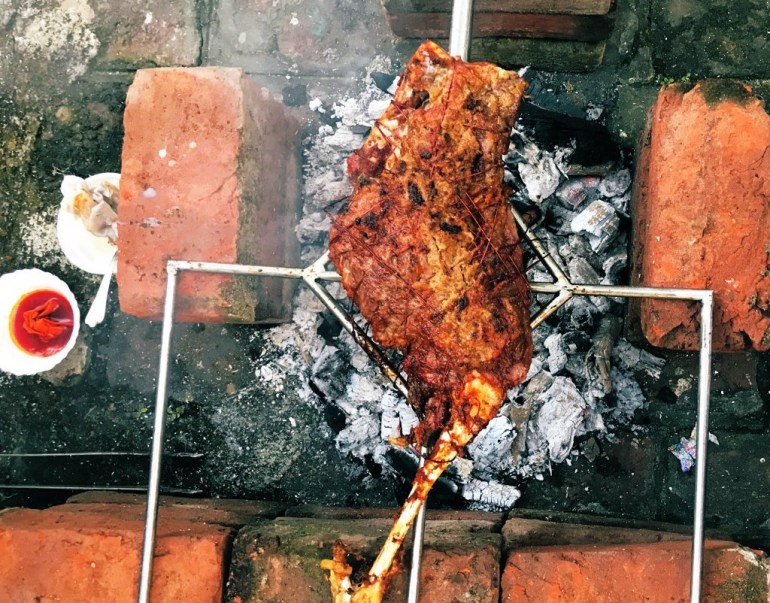
This was the dress of the royal khansamas and one his father, the legendary Ashiq Khansama, wore most of his life. Ashiq Khansama had been sent abroad by Nawab Sayyed Raza Ali Khan (who ruled from 1930 to 1949) to learn English and Continental cuisines.
Nawab Sayyed Murtaza Ali Khan (1923-1982) inherited the Khasbagh Palace kitchens – with 30 chefs and several sous chefs – from his father, Nawab Raza, the last nawab of Rampur. Nawab Raza had downsized the kitchen staff from the 100 cooks employed by his father, Nawab Sayyed Hamid Ali Khan (ruled 1894 to 1930). The palace had three main kitchens – English, Indian and sweetmeats.
Majid Bhai’s first day at work, March 6, 1966, coincided with the funeral of Nawab Raza. The young boy watched mourners from all over the city file past for a last look at their beloved nawab as he lay in state on the palace veranda. Little did he know that the passing of the nawab signalled the beginning of cataclysmic changes as the last vestiges of royal life faded away. The abolition of privy purses in 1971 and court cases for various properties necessitated parsimony by the cash-strapped royal family.
Majid Bhai was a loyalist, taking over all styles of cooking even as other cooks left or were asked to leave. He recounts with a smile how he rescued culinary disasters and catered to unexpected guests and political leaders.

He would stay at Nawab Murtaza’s Delhi home, cooking grand feasts and lording over a small team of sous chefs. Sakina Begum summoned him to her bedside in Mumbai when she was undergoing treatment for cancer.
Finally out of the royal fold
When I started working on the project, Forgotten Food: Culinary Memory, Local Heritage and Lost Agricultural Varieties in India, funded by the UK’s Arts and Humanities Research Council and executed under the University of Sheffield, Majid Bhai came to mind.
He would be the best person to help us resurrect those forgotten dishes of royal Rampur cuisine. I had heard he was in town, so I sent word through my cook. Eid al-Adha was approaching and I was planning a cooking session with the twin objective of hosting an Eid dinner and learning to cook the raan kabab.
Dignified as ever in his now-fading uniform, he held his palm to his forehead in greeting and asked me about my health in chaste Urdu. He had shrunk to a near-skeletal leanness and walked with a stiff hobble; his face was more deeply lined, and his cheeks hollowed with the loss of teeth. His kurta-pyjama had turned grey with years of washing and was peppered with light curry stains.

He told me that he was too old to work and had decided to retire after serving Shehzadi Naghat for more than 20 years. He had taught his sous chefs, two Bihari lads, his skills. He felt they were unworthy of the knowledge, but he had no sons to impart his learning to.
I’m sure that in the tradition of old khansamas he must have kept his secrets, his little pudiya (pouch) of masalas. The princess would miss him for that little nuance of taste that the newly promoted khansamas could never aspire to.
Majid Bhai’s tone with our cook as we prepared for that Eid dinner was supercilious, though his words had become breathy and indistinct. The cook found himself relegated to being an odd-job servant. Majid Bhai didn’t consider him a cook because he was not from a family of cooks, he had learned to cook while working in my in-laws’ kitchens as a young boy. I was glad that I had gotten Majid Bhai’s other requirement for the raan kabab, a three-pronged skewer for the barbecue that we had specially made in steel.
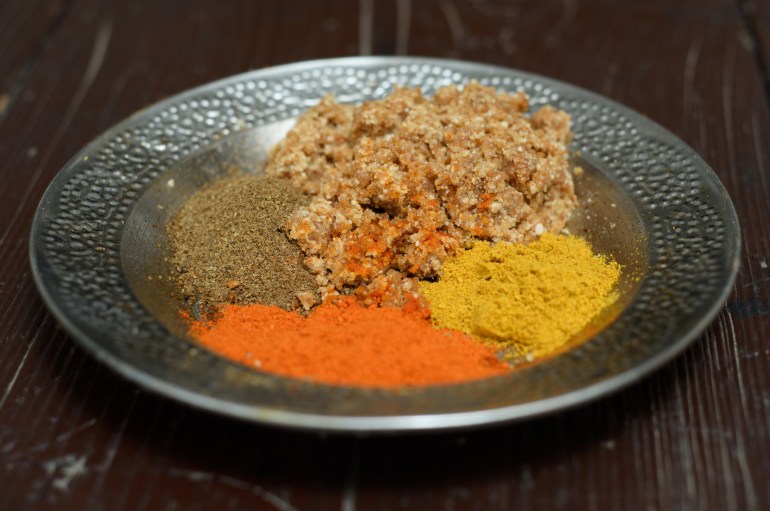
The first marinade was nothing unique – ginger-garlic paste, yellow chilli powder, salt and raw papaya paste – though I meticulously noted everything down. Majid Bhai trimmed the fat off the mutton and mixed the marinade after making the cook grind everything all over again. He slashed the papaya and let the milk drip on the raan, papaya milk is a very potent tenderiser.
This was the usual procedure but what came next was truly amazing. He cut through the thigh to create a flap, exposing the bone, and scraped out some meat to create a hollow; then set the scraped-out meat aside. Next, he rubbed the marinade on the leg and inside the crevice he had fashioned and made deep gashes with a knife all over to settle the masalas into the meat.
The leg was left to rest in the fridge till the next day. I invited him to have lunch, but he refused – he barely ate now after the loss of his teeth.
“Only this cursed tongue remains. It likes nothing now after having tasted from the nawab’s table.”
Once a khansama, always a khansama
I settled down for more tales from the nawab. Maybe at some point in time, Majid Bhai took out his secret masala pouch and though I kept an eagle eye on the proceedings, I did not see that happen. He laughed when I asked him about his secret ingredient.

“I will show you how to cook raan kabab and you can write it down, but every hand has a different flavour. Our Nawab Sahib loved aloo gosht I made it every day for his dinner. He would immediately know if I hadn’t cooked it.”
Majid Bhai was never chatty with me and always treated me with deference. I had to ask him questions and coax out food stories. Only oral history remained of the Khasbagh kitchens, which were in disrepair and practically inaccessible now.
Majid Bhai told me the kitchens had coal-fed ovens that were fired early in the morning and burned till late at night. The daily menu was set by Sakina Begum and the munsarim (administrator) would send the requirements to the store in charge.
In the 1970s Sakina Begum opened a hotel in a part of the palace and Majid Bhai was taught to lay the tables, placement of cutlery and the serving of the courses. I remembered he used to serve us food all those years ago with the tray held at shoulder height and an unpretentious, natural flourish.
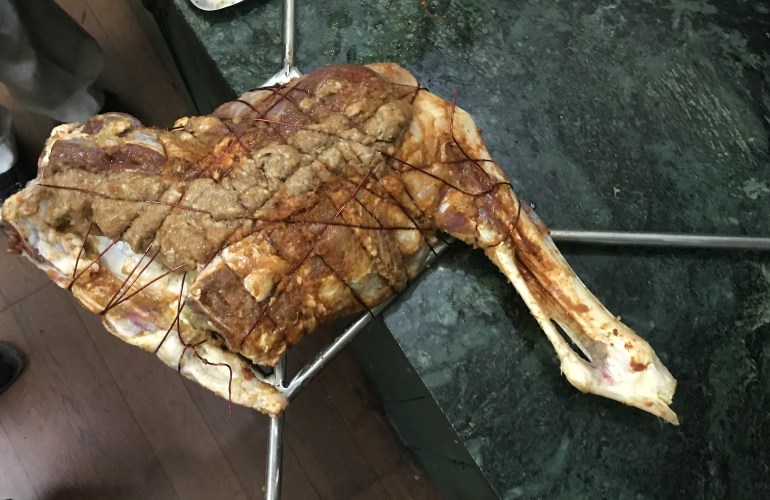
Majid Bhai came over the next day and prepared the second marinade – curd, cashew paste, cream and ghee. He fried onions in ghee with whole aromatic spices and asked the cook to grind them without adding water. The latter had had enough of the sil batta and took out the mixer, ignoring Majid Bhai’s baleful looks.
After reprimanding the cook for not attending to the raan earlier – Didn’t he know that the raan had to be turned over to ensure that both sides were perfectly marinated? – he rubbed in the second marinade. The cook stood muttering and pricking the raan with ferocious annoyance while Majid Bhai set to work on the stuffing.
The sine qua non of the raan kabab is the mincemeat stuffing. Majid Bhai added some more mincemeat to the meat scrapings he had hollowed out from the leg earlier and set to work with a heavy knife making the mince finer. He threw in some basic masalas – garlic paste, red chillies, salt, garam masala spice powder and chopped green chillies. He then sautéed the mince in ghee to take away its raw meat smell. When the mince cooled, he stuffed it into the raan and tied it with a copper wire, assisted by the cook to ensure that the stuffing remained in place and cooked with the meat.

The mutton leg needed to rest for another hour while the cook was instructed to prepare the barbecue. My small barbecue stove was rejected – the fire would be too close to the mutton – and a makeshift barbecue was prepared in the courtyard with bricks set on two ends at an appropriate height for the mutton to slow roast. The cook spread the coals on the brick courtyard, ignited them and sat fanning the fire with a martyred air. I would have to bolster his declining culinary confidence after all this was over.
Majid Bhai tied the raan on the skewer – the three prongs were perfect to rest the bulk of the leg – and set it on the bricks. He sat down on a chair, apologising for sitting in my presence; his knees were too weak to squat on the brick floor. He turned the leg, basting it with ghee, waiting patiently for the colour to change to a light golden, intermittently instructing the cook to add more coals. He declined tea and I knew he wouldn’t eat till the job was done. Maybe he needed to take a bidi smoking break. I moved away and heard Majid Bhai tell the cook to mind the raan and he would return presently.
Rampuri raan
Rampur cuisine had adapted the Mughal dumpukht style of cooking which involved slow cooking food in sealed pans. The royal tables were famous for stuffed chicken and quail slow-cooked with pulao called dumpukht murgh and dum turti respectively. The raan kabab follows the same concept of stuffing minus the pulao. During my research in the culinary archives preserved in the Rampur Raza Library, nowhere did I find a dish akin to the raan kababs.
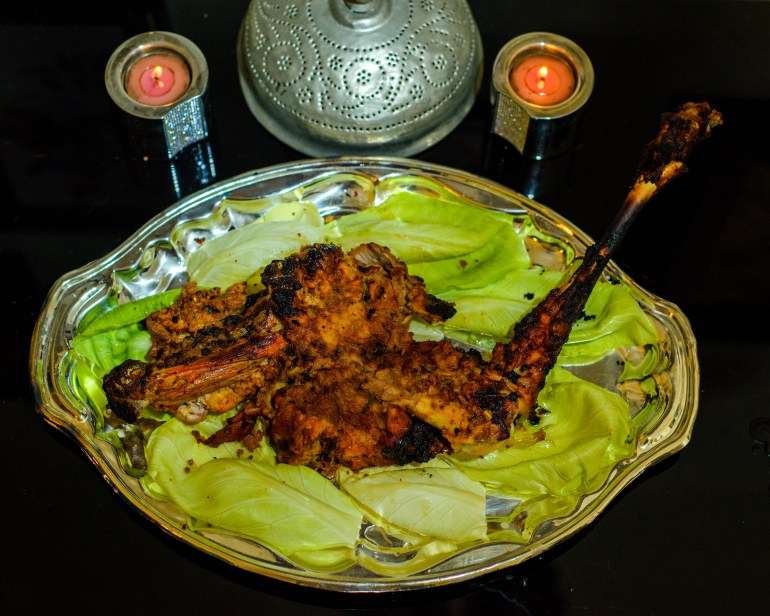
Shahi Dastarkhwan, a cookbook of Rampur cuisine written by Latafat Ali Khan Rampuri and published in 1954, has a recipe for sabut raan kabab (whole leg of mutton kabab) which has the raan marinated for two hours and slow-cooked in a pan. It doesn’t have the mince stuffing or an elaborate double marinating procedure; which leads me to infer that raan kabab was possibly an innovation by a nameless royal chef to earn accolades from the nawab.
The Rampuri raan preparation is distinct from the Mughlai and Awadhi raan, which – with apologies to the Mughlai aficionados – I never preferred because of the thick qorma-like gravy that sits on and around the raan. It is like eating an over-rich qorma with the additional bother of carving the mutton leg. The Rampuri raan has less ginger-garlic and dry fruit pastes and barely-there aromatic spices. The meat is not covered with a thick mush of curry sauce and the marinade is completely absorbed into the meat. The flavours are never too overbearing.
The raan took more than an hour to be cooked to the required tenderness. It was evening and we prepared to receive our guests. Eid al-Adha is a busy time for Muslims with the Qurbani (animal sacrifice) and distribution of meat.
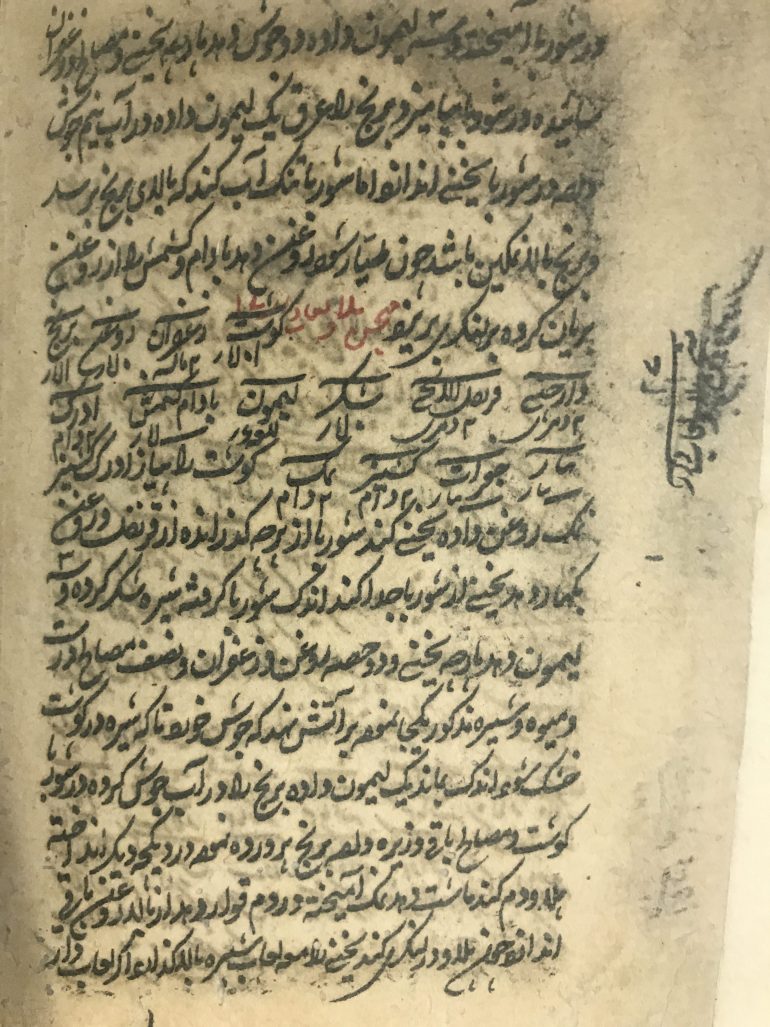
I had invited my non-Muslim friends and they were apprehensive, certain they would be confronted with animal carcasses. I assured them we didn’t perform the Qurbani at home any more.
The tradition of Qurbani on Eid al-Adha mimics Prophet Abraham’s willingness to sacrifice his beloved son at the command of God. The sacrificial animal should be nurtured by the faithful to foster an emotional bond in order to feel the agony of killing it. In our ancestral home, a goat for my grandmother was reared in the open ground, tied to a long rope, perambulating and grazing all day. We children would excitedly feed it, watching it gently pluck the leaves from our hands. Qurbani used to be performed at home in large, rambling kothis and the prescribed portions distributed among relatives and the poor; but now, with smaller houses and less manpower, we have started delegating the task.
The raan kabab was predictably the pinnacle on the dinner table that evening. It was a delicious amalgam of two textures and tastes that melded into each other, one complementing the other. The flavours had penetrated the meat, which was so tender that it was falling off the bone; I barely needed a knife to carve it. The crumbly mincemeat inside had a distinct savour. Every bite was redolent with the charcoal flavour, mixed with a light scent of aromatic spices. Raan kabab was definitely an enhancement from the familiar texture and one clear flavour tone of our usual barbecued leg of mutton.
As I carved the raan for my appreciative friends, ensuring that the mince was ensconced in the meat layer, I remembered Majid Bhai’s parting words,“ Learn as much as you can from me Begum Sahiba. I’m now like the morning lamp, soon to be extinguished.”


